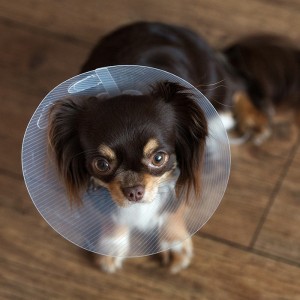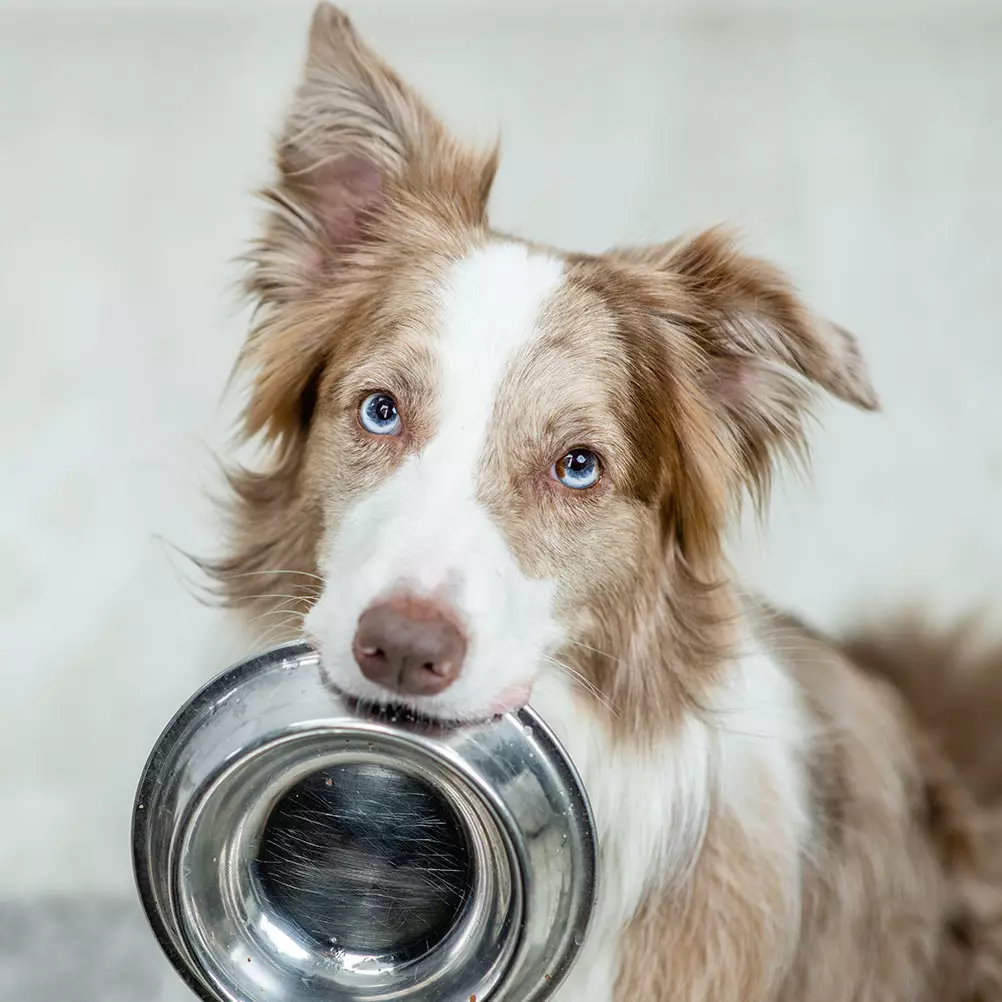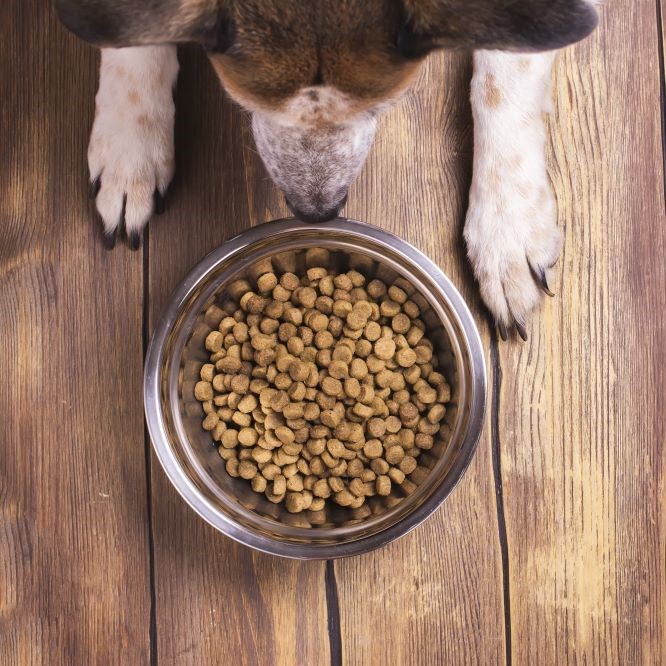How long are dogs pregnant? Dog pregnancy & gestation
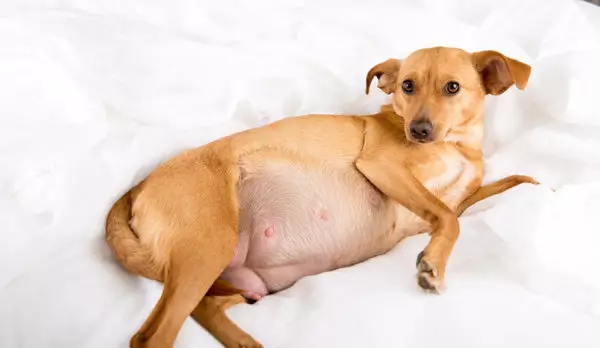 If you own a female dog that hasn’t been de-sexed, there is a chance she could become pregnant when she comes on heat – even the very first time this occurs and even if she is still a puppy.
If you own a female dog that hasn’t been de-sexed, there is a chance she could become pregnant when she comes on heat – even the very first time this occurs and even if she is still a puppy.
If your dog does fall pregnant, whether planned or unplanned, there will probably be many questions running through your mind, questions such as:
- How long are dogs pregnant?
- What are the stages of dog gestation?
- How do I care for my dog while she is pregnant?
- How will I know when my dog is in labour?
In this article we answer these questions and more and help you navigate the issues you may face if your dog falls pregnant.
How long do female dogs stay in heat?
Female dogs that have not been spayed usually have 2 “heat” periods per year, about 6 months apart, although this can vary depending on the dog and the breed and can occur from one to three times per year. The first heat usually takes place between 6 and 18 months of age, typically starting later in larger breeds, and dogs can become pregnant during their very first heat.
The heat cycle lasts for 2 to 3 weeks and is comprised of 3 stages:
- Proestrus – the first stage of the heat cycle, lasting for about 9 days. Females start to attract males, although they will typically reject their advances until stage two.
- Oestrus – the second stage can last from 3-to-4 days to 7-to-11 days. This is the time of ovulation, when pregnancy is most likely to occur and when the female is most receptive to the male’s advances.
- Diestrus – the final stage of the cycle, typically occurring around day 14 at which time the female will no longer permit mating.
During this time, you may notice some signs that typically occur when a dog is in heat:
- Increased alertness and restlessness
- Swollen vulva
- More frequent urination, which could lead to accidents
- Vaginal bleeding
The heat cycle can be considered complete when the vulva returns to normal size, rather than when bleeding stops. The period between one heat cycle and the next is called “anoestrus”, which usually lasts around six months.
How will you know if your dog is pregnant?
You may only start to suspect that your dog is pregnant when certain signs appear, usually within the first few weeks of pregnancy, that may raise some alarm bells:
- Her appetite may change (either increasing or decreasing)
- She may crave certain snacks or chew toys
- She may appear to have ‘morning sickness’
- Her behaviour may change (e.g. nesting behaviour, more clingy than usual or avoiding touch and interaction)
- Her nipples will darken and enlarge, and the surrounding area will start to swell
However, to really know for sure if she is pregnant, you will need to visit your veterinarian for confirmation. If possible, tell your vet your best estimate of the time of conception, as the pregnancy testing methods for dogs are time sensitive.
There are four methods veterinarians can use to determine if a dog is pregnant:
- Ultrasound
- Palpation
- Hormone test
- X-ray
Ultrasound
An ultrasound is the best way to find out if a dog is pregnant early on, between days 25 and 35 of the dog gestation period. Ultrasounds not only detect pregnancy; they also register the foetal heartbeats and can help calculate the gestational age of the foetus.
Palpation
 Physical examination by means of palpation, feeling with the hands and fingers from the outside of the body, is the cheapest and most convenient way to diagnose pregnancy in dogs. As the foetuses develop, the membranes around them grow to form fluid-filled sacs which the vet can feel between days 21 and 35 of the dog gestation period (approximately three-to-four weeks).
Physical examination by means of palpation, feeling with the hands and fingers from the outside of the body, is the cheapest and most convenient way to diagnose pregnancy in dogs. As the foetuses develop, the membranes around them grow to form fluid-filled sacs which the vet can feel between days 21 and 35 of the dog gestation period (approximately three-to-four weeks).
Hormone Test
Vets can test for the hormone relaxin, which is released from the placental tissue only during pregnancy. This test is only reliable if done more than 30 days into the dog gestation period; tests taken before then can have a false negative.
X-ray
X-rays are most effective later in pregnancy, after the 55th day of the dog gestation period, as from this point in the pregnancy the number of foetuses can be accurately established. Additionally, an x-ray at this stage can determine how far along the pregnancy is, so that the delivery date can be estimated.
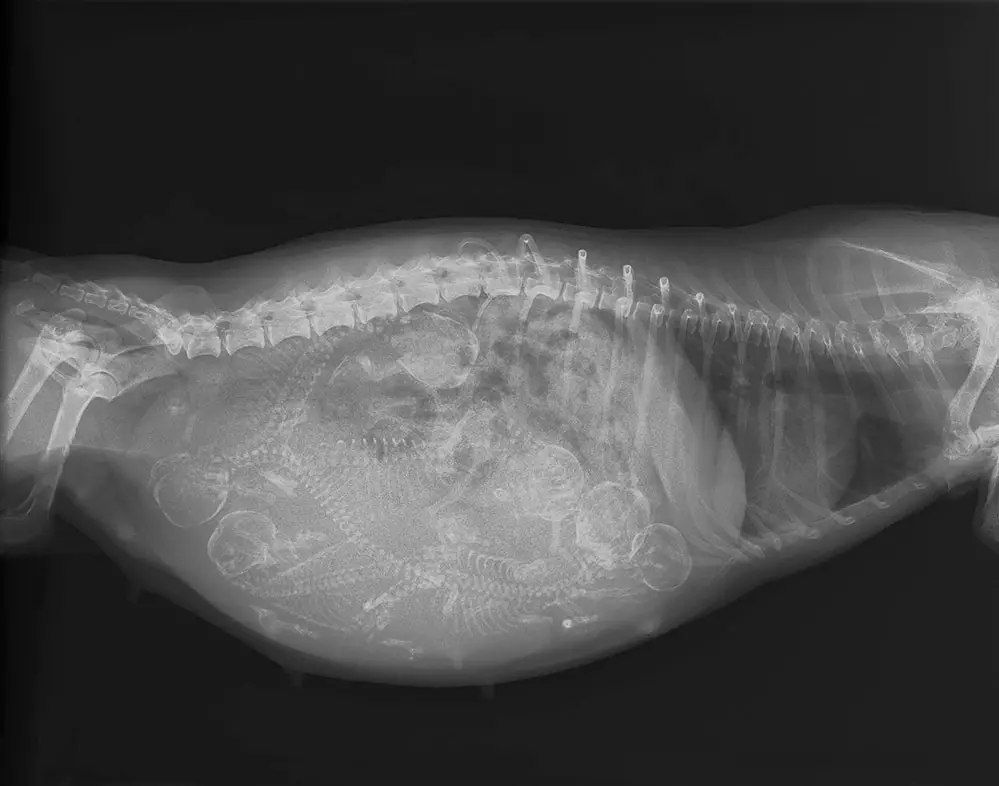
For how long are dogs pregnant?
The typical duration of the dog gestation period is 63 days from conception, although this can vary from 56 to 70 days, depending on the breed. There are variations in the length of pregnancy because conception may not necessarily occur at the precise time of mating, with sperm being able to survive for up to a week inside the female.
- How long do dogs stay pregnant for in months? Around 2 months
- How long are dogs pregnant for in weeks? Around 9 weeks
- How long is a dog pregnant for in days? Around 63 days
Finding out that your dog is pregnant can come as a huge surprise. However, it’s best not to stay in shock for too long, as the dog gestation period is brief compared with ours, and the more prepared you are early on, the more positive and stress-free the pregnancy and birth experience will be for you and the mum-to-be.
What are the stages of pregnancy?
There are three stages of dog gestation, with each trimester around 21 days long. Dogs pass through these stages of pregnancy quickly, with the foetuses developing rapidly inside the womb over the 9 weeks of pregnancy. Certain signs are characteristic of each of the stages.
Trimester One
The dog’s uterus is shaped like the letter V, with each half called a ‘horn’. Around the seventh day of pregnancy the embryos travel to the uterine horns. By week 3 the embryos embed in the uterine lining, spaced out evenly along it, where they will continue to develop.
Many dogs do not show any signs of pregnancy during the first three weeks. If they do, these may include:
- Increased appetite
- Slightly enlarged nipples
- More affectionate behaviour
- Clear vaginal discharge (around week four)
- Decreased physical activity
- “Morning sickness” during weeks 3 to 4
- Slight weight gain

Trimester Two
The foetuses begin to take shape by day 22, and by day 28 or 30 the foetal heartbeats are detectable on an ultrasound, with the foetuses around the size of walnuts. Foetal development progresses rapidly during the second month, with the organs starting to form. Eyelids form by day 32 and toes are visible by day 35.
Signs of pregnancy are much more obvious during the second trimester:
- Noticeably increased appetite
- Nipples are darker and larger
- Increased belly size
- Weight gain of 20 to 50 percent
- Increased urination
- Behavioural changes
- Clear, odourless vaginal discharge
Trimester Three
The foetus starts to look like a dog, with the skeleton becoming solid, the coat and claws forming, and weight increasing. By day 50, an x-ray can confirm the number of puppies in the litter. Puppy development is almost complete by around day 58, and the puppies will begin to move into whelping position in the birth canal over the last few days of the pregnancy. The dog will start looking for a place to nest around this time, and she may appear anxious and irritable. Other symptoms of this trimester include:
- Enlarged, firm abdomen (days 45 to 50)
- Enlarged breasts (milky fluid may leak out)
- Decreased appetite (day 45)
- Visible puppy movement in abdomen (day 50)
Signs during the last few days of the dog gestation period:
- Waist will trim as puppies move into the birth canal
- Appetite loss around day 61 or 62
- Drop in body temperature 12-to-24 hours before labour
- Restless behaviourPacing, panting, shivering, or digging
How to care for your pregnant dog
Dogs are fairly self-sufficient, and as long as you attend to their nutritional needs and keep the stress at a minimum, caring for a pregnant dog isn’t all that different from at any other time. In the early weeks, you can continue to groom, feed and walk her exactly as you did before. However, labour can be hard work, and maintaining her health and fitness during the gestation period will help with easing the stresses of labour.
A consistent routine of walking is recommended; several short walks a day close to home will keep her fit and avoid boredom. The closer to delivery, the shorter the walk should be. Carefully observe her behaviour – if she doesn’t want to go for a walk don’t force her.
What should you feed your dog during pregnancy?
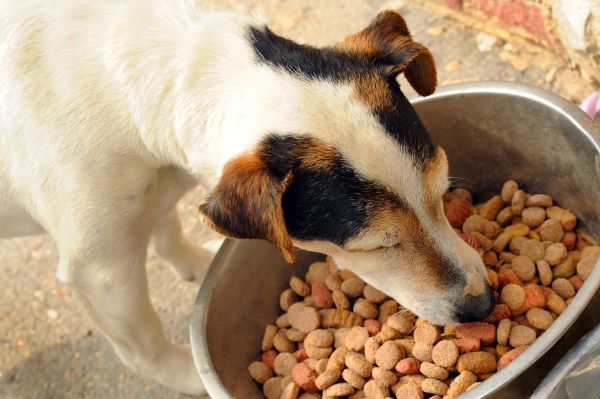
A high-quality, well-balanced diet is essential during pregnancy. However, your dog’s nutritional requirements increase only minimally during the first half of gestation; her weight should remain relatively stable, increasing by no more than 10%. Therefore, it is not necessary to change, or increase the quantity of, her food in the first few weeks. Continue to feed her normally but monitor her for an increase in appetite. No supplements are needed at this stage unless prescribed by the vet.
During the second half of pregnancy, rapid foetal growth occurs and her nutritional needs will increase by up to 3 times her normal requirement. Adjust her diet accordingly, avoiding any dramatic changes: gradual increases up to the time of whelping will ensure adequate weight gain and sufficient nutritional reserves.
She will need a performance diet with more protein and a higher energy content. As a guideline, choose a highly digestible, very palatable commercial diet containing around 30 percent protein and 17 percent fat. There are commercial dog foods designed especially for pregnant dogs that contain the correct balance of protein, fats, carbohydrates, minerals and vitamins.
If her appetite appears to decrease, it is usually because of abdominal discomfort, and changing her meal schedule to smaller, more frequent meals is recommended. Be careful of overfeeding and avoid feeding her excessive scraps and treats.
Following your vet’s advice, you may wish to add in a multivitamin to her diet. Ensure that her food is high in fatty acids, specifically EPA and DHA. Studies show that these fatty acids help in brain development. Never feed your dog human supplements.
Maintaining adequate nutrition during the last trimester and while nursing, by feeding progressively greater amounts of high-quality, well-balanced and palatable growth and lactation diet, is critical to support the mother and her pups and to assure their future good health.
When to seek veterinary advice
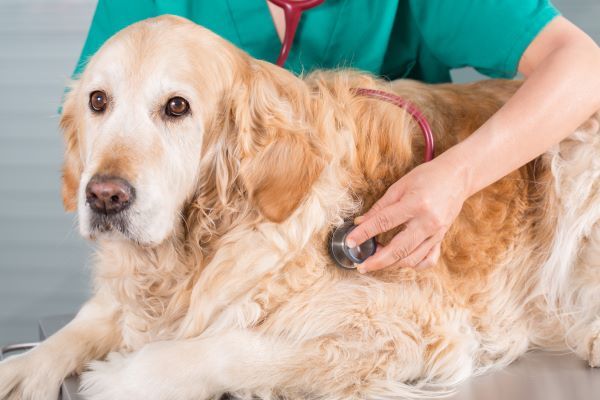
If you think your dog is pregnant, you should take her for a prenatal check-up around 30 days (four to 4 and a half weeks) into the pregnancy. Your vet can confirm the pregnancy, provide medical and dietary advice, answer any questions you may have, perform any necessary tests, and treat any parasites that may be present. An ultrasound can be arranged to confirm the pregnancy and to determine the size of the litter. Your vet may schedule further visits during the later stages of the pregnancy. A check up by the Vet during pregnancy provides an opportunity to check on diet, worming and vaccination status.
Additionally, you should consult the vet at any stage during the gestation period, labour or post-partum if you have any concerns about your dog, including the following:
- Abnormal vaginal discharge
- Bloody discharge
- Abnormal behaviour
- Refusal to eat
- Signs of pain
- Fever
- Early or late labour
- Delays / lack of progress during labour
- Complications during labour
- Lack of care for her pups
- Mastitis
- Inadequate milk production
- Milk fever (eclampsia)
Vaccination and worming during pregnancy
Maintaining your dog’s vaccination and parasite control is essential during pregnancy. It is important to continue with her healthcare and preventative treatments such as intestinal worming, heartworm prevention and flea control while she is pregnant. If you’re not sure if any of the products you are using will harm her, check with your vet.
Ideally, before pregnancy your dog should be evaluated and treated for parasites (internal and external) that could impair her health or be transmitted to her offspring. Hormonal changes during pregnancy cause immature roundworms that are sitting in the tissues of the body to become active and even enter the milk supply, infecting the puppies when they feed from her. Hookworms can also be transferred through the milk. She will need to be wormed 10 days prior to giving birth and every 3 weeks while she is nursing her pups. The puppies will need to be wormed from 2 weeks of age and every 2 weeks thereafter until 12 weeks of age.
Your dog should also be given all appropriate vaccinations, as determined by your vet, prior to becoming pregnant. If this is an unexpected pregnancy, a vaccination for Parvovirus is recommended no later than 6 to 7 weeks into the pregnancy. Parvovirus remains one of the most common causes of puppy deaths and vaccinating the mother prior to giving birth provides her with good Parvovirus antibodies which she will transfer to her pups.
Preparing for the birth of the puppies
As end of the gestation period approaches, one of your most important tasks is to prepare an area or whelping box, the “nest” in which your dog will give birth to and care for her puppies. She may seek out a quiet place herself, and you may observe her lying in a particular area or dragging her blanket there. You may use her chosen spot or encourage her towards the area or box you have chosen by moving her favourite toys and bedding there. Ideally, the selected space should be away from the general flow of household traffic.
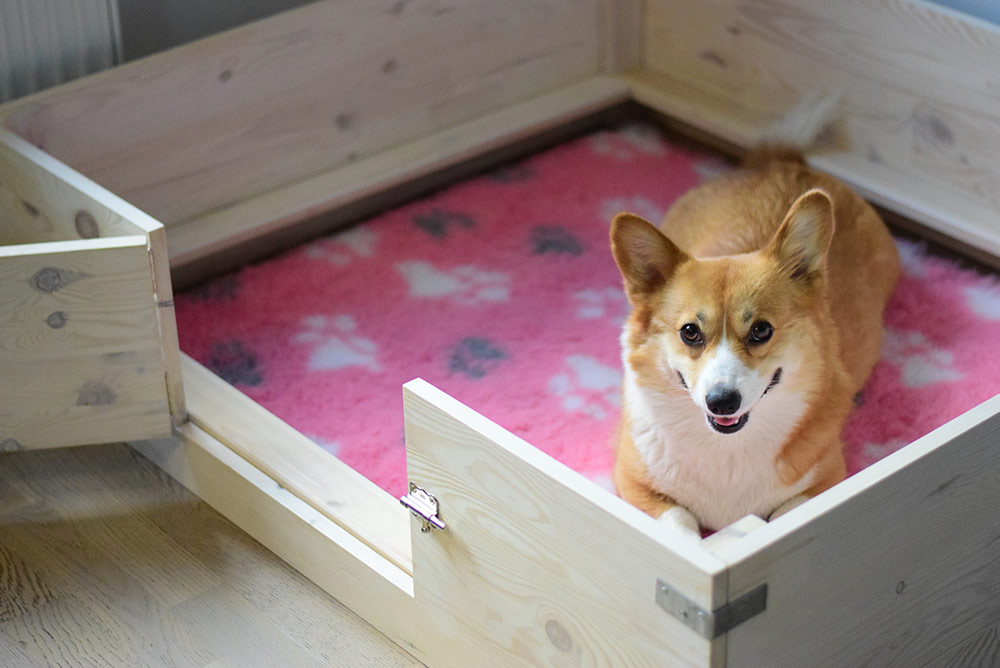
The sides of the box or barrier around the space should be high enough to keep the puppies in and avoid drafts, but low enough for mum to step over, with easy access to the outside as well as her food and water. Line the floor with waterproof material and /or plenty of newspaper, both for insulation and absorption, and cover these with plenty of clean towels, sheets or blankets. These will need to be washed often or even discarded after the birth, as they may get ruined. You will need additional towels and blankets for cleaning up after the birth of each puppy.
Temperature-control of the whelping area is also important, as very young puppies cannot maintain their body temperature. If necessary, provide heating so that during labour and whelping the room temperature is maintained at approximately 30°C and thereafter at around 25°C.
What are the signs of labour?
There are three stages of labour, with the signs of the onset of labour occurring in stage one; this stage can last from 12 to 24 hours. Both the strength and frequency of contractions in the muscular wall of the uterus increase throughout stage one, but no visible contractions are noticeable. However, the following signs and symptoms of labour in dogs may be evident:
- Change in disposition and behaviour, e.g., restlessness, anxiety, irritability, reclusively
- Intermittent nesting
- Refusing to eat
- Vomiting
- Panting
- Clear vaginal discharge
What to do when your dog gives birth and afterbirth care
When it is clear that your dog is in labour (see above: “What are the signs of labour?”) gently guide her to the whelping box if she is not already there. From there on it’s best to trust her instincts while following any advice your vet has provided. Most importantly, keep calm and attend to her needs as best as possible as she may become stressed if you show signs of stress.
While not crowding her, be close enough to keep an eye on how she is progressing. You don’t have to be in the whelping area all the time, and if things are taking their time, check in every 15 minutes or so. If other family members, including children, want to watch, let them do so one at a time, keeping quiet and not disturbing mum.
How long will it be between pups?
Puppies are delivered during the second stage of labour. This can last from one to 24 hours, as mum delivers one puppy at a time with each delivery generally taking from one to two hours and around 30 to 60 minutes between deliveries. It is useful to know how many puppies are expected, for you to know when labour is over and be able call the vet if you suspect any complications.
As the puppies are born, mum should tear open the foetal sack, which she may eat – a normal but not necessary behaviour. If she doesn’t open the sack, put on some disposable gloves and do this yourself. Some placenta will be expelled behind each puppy. Once the last puppy and placenta are delivered, clean up the whelping area, replacing all the soiled bedding with clean blankets and towels.
Be sure to know what signs to look out for during labour that could indicate a complication, such as excessive delays between puppies, a puppy getting stuck in the birth canal, a placenta not passing or any signs of distress from mum. Have your vet’s contact details on hand so that you can get in touch right away if necessary.
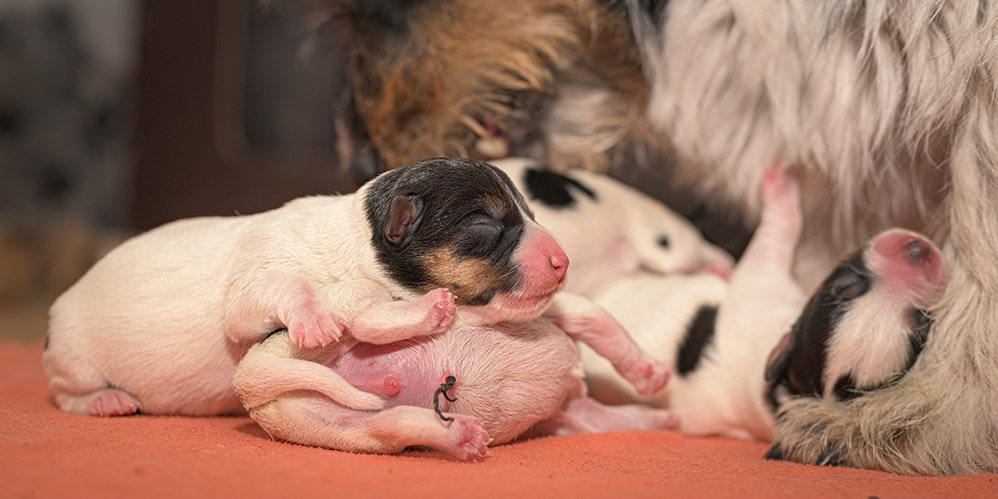
While mum spends her time and energy cleaning and nursing her puppies, your main role is to take care of her. Provide her with ample high quality, nutritious food and plenty of fresh, easily accessible water, both of which are essential for sufficient milk production. The more puppies there are in the litter, the more demanding it will be on her to feed and care for them. Allow her and the puppies to rest as much as possible while checking in on them regularly. Examine her regularly for signs of fatigue, infection, blocked teats and even malnutrition. Make sure to contact your vet if you have any questions or concerns during the afterbirth period.





